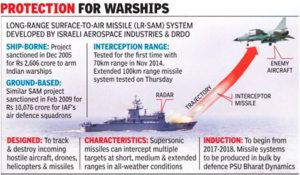Long Range Surface-to-Air Missile (LRSAM)
- India has successfully flight tested Long Range Surface-to-Air Missile (LRSAM) from a warship off Odisha coast.
- The LRSAM has been developed through a joint venture between DRDO India and IAI of Israel.
- The LRSAM successfully destroyed a low flying aerial target.
- This paves way for its deployment in the armed forces.

Medium Range Surface to Air Missile (MRSAM)
- The Army version of MRSAM is a Surface to Air Missile.
- It is developed by India’s Defence Research & Development Organisation (DRDO) in collaboration with Israel Aerospace Industries (IAI) for use by the Indian Army.
- The MRSAM Army weapon system comprises Command post, Multi-Function Radar and Mobile Launcher system.
- It is a 4.5m long nuclear-capable ballistic missile which weighs around 2.7 tonne and can carry a payload of 60 kg.
- The launching platform includes a Multi-Functional Surveillance and Threat Alert Radar (MFSTAR) for detection, tracking, and guidance of the missile.
- The new generation MRSAM has been developed to neutralise airborne threats like jets, missiles and rockets, including projectiles launched simultaneously.
- MRSAM is a land-based configuration of the long-range surface-to-air missile (LRSAM) or Barak-8 naval air defence system, which is designed to operate from naval vessels.
Quick Reaction Surface-to-Air Missile (QRSAM)
India successfully test-fired on 13 November 2020 the Quick Reaction Surface-to-Air Missile (QRSAM) system at an integrated test range in Chandipur off the Odisha coast. The successful test-firing of the QRSAM, having a range of around 30 km, paves the way for its commercial production.
- The missile is propelled by a single-stage solid propellant rocket motor and uses all indigenous subsystems.
- The system is capable of detecting and tracking targets on the move and engaging targets with short halts.
- The system is designed to give air defence coverage against strike columns of Indian Army.
- The missile is canisterised for transportation and launch using a mobile launcher capable of carrying 6 canisterised missiles.
- All QRSAM weapon system elements like Battery Multifunction Radar, Battery Surveillance Radar, Battery Command Post Vehicle and Mobile Launcher were deployed in the flight test.
- The radar tracked the Banshee target from the farthest range and the missile was launched when the target was within the kill zone and achieved the direct hit with terminal active homing by RF Seeker guidance. Various DRDO labs DRDL, RCI, LRDE, R&DE(E), IRDE, ITR have participated in the test.
- The weapon system elements have been realized through Defence PSUs BEL, BDL and private industry L&T.
- The missile system is fully indigenous with active RF Seekers, Electro-Mechanical Actuation (EMA) systems sourced from various industries.
- The Radar is a four-walled Active Phased Array Radar. All range Tracking stations, Radar, EOTs and Telemetry Stations monitored the flight parameters.
- In the last two months, India has test-fired a number of missiles including a new version of the surface-to-surface supersonic cruise missile BrahMos and an anti-radiation missile named Rudram-1.
Barak 8 Missile
- Barak 8, also known as LR-SAM or as MR-SAM, is an Indo-Israeli surface-to-air missile (SAM).
- It is designed to defend against any type of airborne threat including aircraft, helicopters, anti-ship missiles, and unmanned aircraft as well as ballistic missiles, cruise missiles and combat jets.
- Both maritime and land-based variants of the system exist.
- It was jointly developed by Israel Aerospace Industries (IAI), Defence Research & Development Organisation (DRDO), Israel’s Administration for the Development of Weapons and Technological Infrastructure, Elta Systems, Rafael and other companies.
- India’s Bharat Dynamics Limited (BDL) produces the missiles.
















